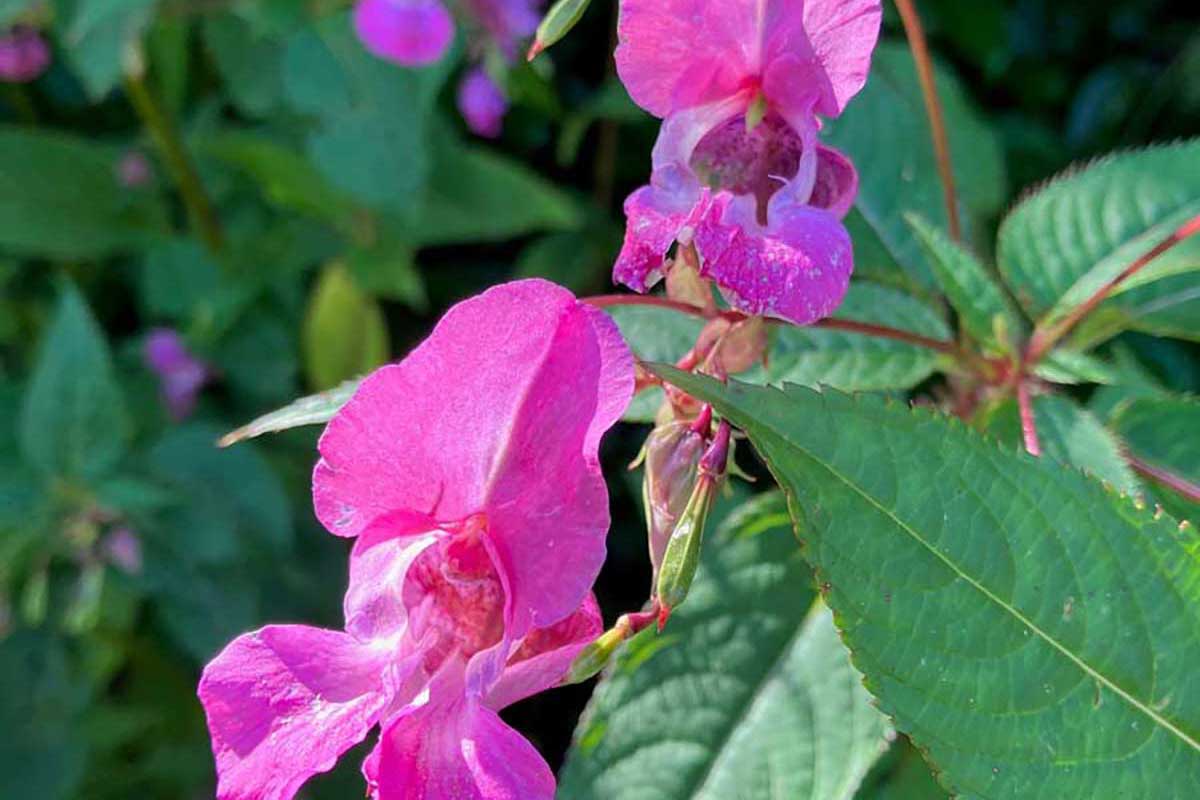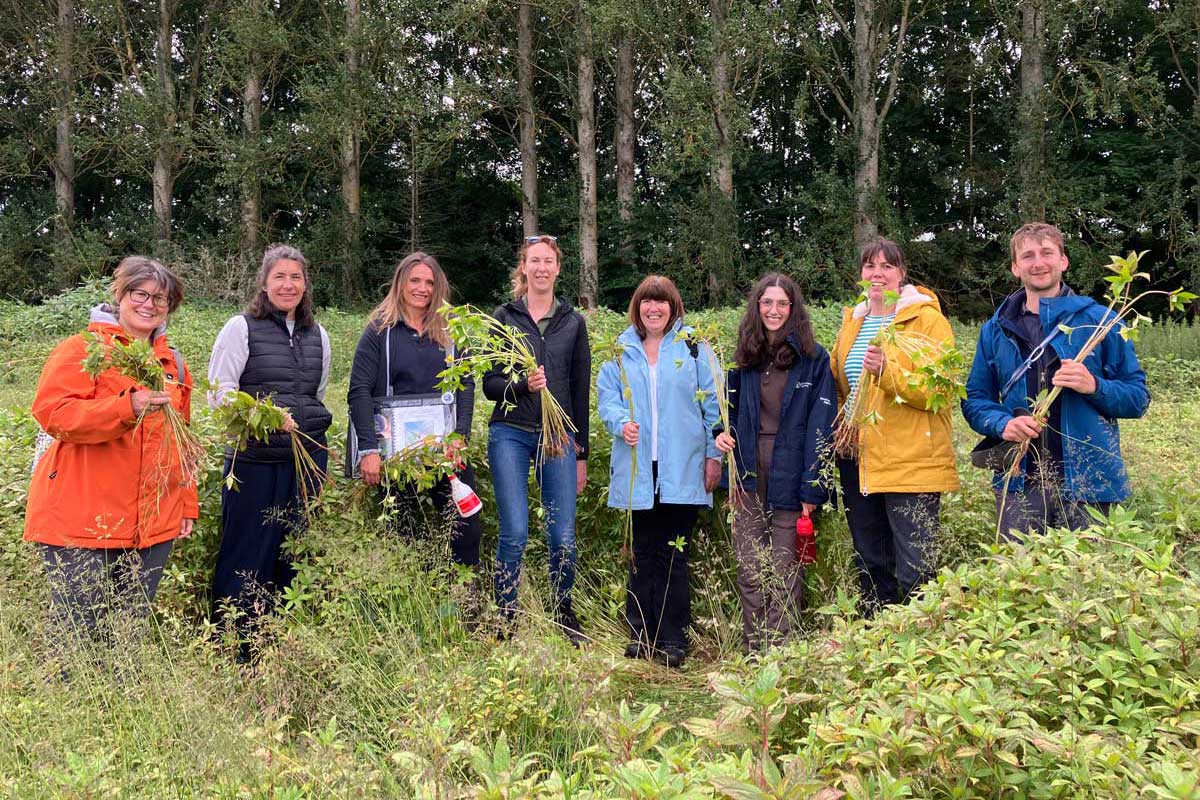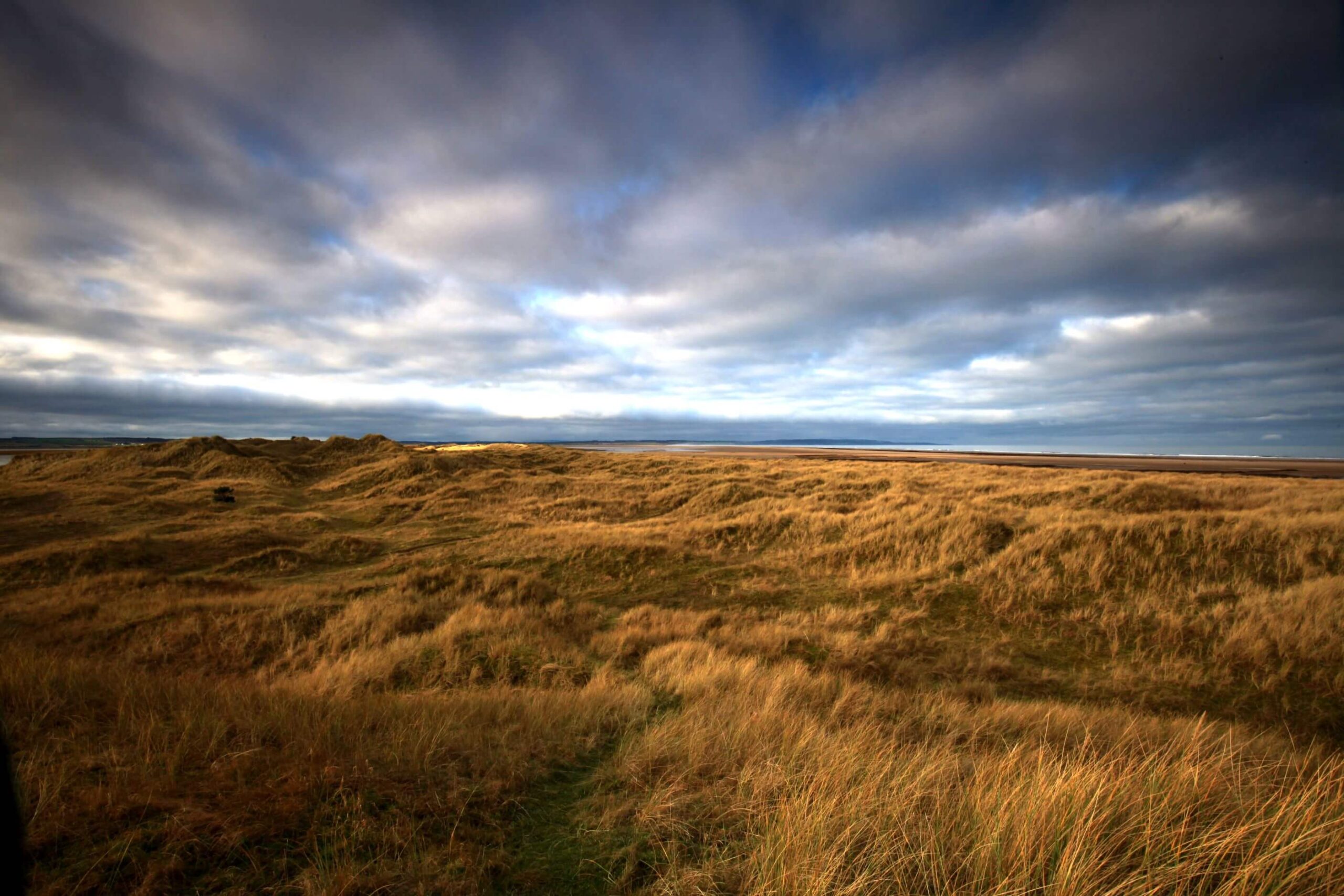
Prunus spinosa
Blackthorn is native to Europe and western Asia and can also be found in New Zealand and eastern North America. It was likely introduced as an ornamental, and to harvest berries and wood. It grows best in moist, well-drained soil and so can often be found in dune landscapes. Spiny and densely branched with black-purple twigs, small, narrow leaves and sharp thorns, mature trees can grow to a height of around 6–7m and live for up to 100 years. The dark brown bark is smooth, and twigs form straight side shoots which develop into thorns.
Blackthorn can spread quickly by root suckering and seed dispersal, outcompeting native species. Gradually, a blackthorn infestation will expand in a circular pattern, creating an impenetrable hedge. This can cause habitat degradation for certain wildlife.
Further reading:
Dune management and invasive species in the UK and Ireland: current position and future challenges
Hippophae
Sea-buckthorn is a spiny, thicket-forming shrub of sand dunes. It’s native to the east coast of England but considered an invasive species elsewhere. It is most obvious in autumn when it is full of bright orange berries.
It is now common across the sand dune systems of the UK, including those in Northumberland, where it was initially planted to help stabilise the dune systems but has since spread and become invasive. The dense thickets can out-compete and shade out smaller species that would typically inhabit areas of mobile dunes.
Further reading:
Symphoricarpos albus
A native of North America, Snowberry was introduced to the UK in the 1800s. Favoured for its ability to grow rapidly, it was planted extensively to provide dense cover for game birds, as hedging and to stabilise riverbanks. This provided a corridor for further spread and the deciduous shrub now thrives in dunes, hedgerows, riverbanks, estates and older or abandoned gardens.
Snowberry can grow to a height of 2m, and is characterised by whippy, bright brown, shiny branches. From spring to the summer, clusters of tiny bright pink, bell-like flowers appear, followed in late summer by waxy-looking, poisonous white berries. The plant’s root system (rhizome) can grow rapidly and out-compete native plants. Once established it can form dense thickets and suppress the growth of native plants.
Further reading:
Acer pseudoplatanus
Sycamore is native to central, eastern and southern Europe. It is thought to have been introduced to the UK by the Romans and the earliest reports of the species naturalising in the UK date from the mid-1800s. The seed is extremely fertile, so it has spread quickly across the UK and colonised many woodlands to the detriment of native species.
Dune systems are particularly prone to colonisation by Sycamore where it can swamp natural vegetation, reduce biodiversity and cause detrimental stabilisation.
Further reading:
Hedera
Ivy is an evergreen, woody climber which can grow to a height of 30m. Although native to the UK (and so not strictly an INNS), it is an invasive species that spreads quickly, forming a dense monoculture which reduces biodiversity and consequently prevents the growth of native plants. Ivy Hedera Helix is causing huge problems in the ramparts of Bamburgh Castle where it is suffocating the fragile dune ecosystem.
Acaena novae-zelandiae
Pirri Pirri is a prickly problem on the Northumberland coast, especially on Lindisfarne National Nature Reserve. It is a plant species native to New Zealand and Australia and was first recorded in the UK in 1901, most-likely introduced on the fleeces of imported sheep.
Pirri Pirri is a small shrubby plant that forms dense mats which often suffocate native species. It produces balls of reddish flowers in late spring which ripen into red, barbed fruits, called burrs, which turn brown during the summer. The seed burrs spread easily in mid to late summer by attaching onto anything that passes – boot laces, socks, dogs, wings of wildfowl and livestock. Spread can be minimised by keeping to the main paths through the dunes between June and November, and removing (and binning!) seeds from shoes, clothing and dogs.
Further reading:
Lysichiton americanus
American Skunk Cabbage is native to Western North America, and was originally introduced to the UK as an ornamental plant in 1901. It was first recorded in the wild in Surrey in 1947. It prefers damp habitats such as wet woodland, stream sides and muddy pond margins, but can grow in almost any soil type.
Yellow flowers are produced in spring that resemble those of wild arum (lords-and-ladies) and emit a strong odour like that of a skunk. ASC is a hardy perennial lowland plant with a rosette of stemmed leathery leaves at its base, and can grow up to 1.5m in height. Seeds are dispersed by waterways, birds and mammals and are able to root as dense stands that may outcompete and shadow native plants.
Impatiens glandulifera
Also known as ‘Policeman’s Helmet’, Himalayan Balsam is native to the west and central Himalayas, and was introduced as an ornamental garden plant in the early 19th century. It was first recorded in the wild in 1855, and is found mostly on river banks, in damp woodland and other damp habitats. It is now widespread in the UK, especially along urban rivers.
Himalayan Balsam is a tall, attractive, annual herb with explosive seed heads. Although easy to identify as a mature plant with its pink-purple flowers, fleshy stem and characteristic leaves, the seedlings and last year’s dead stems are more difficult to spot. It spreads solely by seeds, which are small and easily carried by wind or water. Balsam out-competes native species in ecologically sensitive areas, particularly river banks. Where it grows in dense stands along river banks it can also impede flow at times of high rainfall and increase the likelihood of flooding. When its extensive stands die back in winter, river banks can be left bare and exposed to erosion. Himalayan Balsam is listed under Schedule 9 to the Wildlife and Countryside Act 1981 with respect to England and Wales, and it is an offence to plant or otherwise allow this species to grow in the wild.
Further reading:
Cotoneaster
Cotoneaster is native to east Asia and thrives on rough ground.
It comprises a large group of small trees and shrubs which can be evergreen or deciduous with characteristic red berries and shiny leaves. The plant has been in cultivation in GB since 1824 and there are now over 100 different species in the UK. Cotoneaster spreads easily through the digestion of its berries by birds, and where it becomes established can become dominant to the exclusion of native species. It is listed under Schedule 9 of the Wildlife and Countryside Act 1981 – as such, it is an offence to plant or otherwise cause these species to grow in the wild.
Further reading:
Rosa rugosa
A native of China, Japan and Korea, Japanese Rose was introduced into cultivation in the UK in the late 18th century, but not successfully grown until the mid-19th century. It is now very common in parks and gardens, and was first recorded in the wild in Cumberland in 1927 as a result of garden escapes/waste. Its distribution in the wild is increasing, and it has now become highly invasive in the fragile dune systems of Northumberland.
Japanese Rose is a vigorously suckering, deciduous shrub with many slender thorns on its stems. Its characteristic purplish-pink flowers make it readily distinguishable from other roses found in the wild. It can form extensive and dense thickets, which can smother native species and reduce biodiversity. Japanese Rose is listed under Schedule 9 to the Wildlife and Countryside Act 1981 and it is an offence to plant or otherwise allow this species to grow in the wild
Further reading:
Hydrocotyle ranunculoides
Floating Pennywort is a native of North America which naturalised in the UK in 1990 from discarded plants from garden ponds. It can be found floating on the surface of still or slowly moving freshwater. Pennywort spreads rapidly, and can grow up to 20cm per day – either free-floating or rooted, it can quickly dominate a waterbody forming thick mats and impeding water flow and amenity use.
This highly invasive plant can out-compete native species by blocking out light, causing deoxygenation, obstructing insects from reaching the water surface and reducing water temperatures. It is listed under Schedule 9 to the Wildlife and Countryside Act 1981 and it is an offence to plant or otherwise cause this species to grow in the wild.
Further reading:
Heracleum mantegazzianum
Giant Hogweed is a native of the Caucasus mountains in south west Russia and Georgia. It was brought to the UK as an ornamental plant and was first recorded wild in the UK in the late 19th century. It is generally found on riverbanks and in damp meadows, but it can also be found on waste ground. It is highly invasive. Each plant can survive for up to 15 years and produce up to 50,000 seeds, easily spread by water and wind.
Giant Hogweed is now common across much of the UK, and contact with any part must be avoided as even minute amounts of sap can cause blistering of the skin. Other negative impacts include out-competing native flora, river bank erosion and increased flood risk. Giant hogweed is listed under Schedule 9 to the Wildlife and Countryside Act 1981 with respect to England, Wales and Scotland and it is an offence to plant or otherwise cause this species to grow in the wild. Under the Environmental Protection Act 1990, giant hogweed is also classified as controlled waste.
Further reading:
Fallopia japonica
Japanese Knotweed , or ‘Japanese Bamboo’, is native to Japan, Taiwan and Northern China. It is a tall herbaceous perennial with bamboo like stems, and often grows into dense thickets. It was introduced in the early 19th century as an ornamental plant but is now common and widespread across the UK. Knotweed spreads rapidly via fragments of rhizome or stem, of which very little is needed to start a new plant. These can travel by wind or water or via shoes, tyres or any surface that comes in contacxt with the soil nearby. It outcompetes native flora, contributing to river bank erosion and increasing the likelihood of flooding. It can also cause significant delays and cost to development as well as structural damage (it can grow through asphalt and some other surfaces). Japanese Knotweed is listed under Schedule 9 to the Wildlife and Countryside Act 1981 and it is an offence to plant of otherwise cause Japanese knotweed to grow in the wild. Under the Environmental Protection Act 1990, Japanese Knotweed is classified as controlled waste.
Read more:
ID_Fallopia_japonica_(Japanese_knotweed)
Undaria pinnatifida
Wakame is a large species of seaweed originating from the Pacific and is considered by the IUCN Invasive Specialist Group to be one of the 100 ‘world’s worst’ invasive species, due to its potential to impact ecological and economic interests. Scientists do not currently believe that the true spread of the species is known for Great Britain and North West Europe.
This kelp is dark green / brown in colour with a claw shaped/ branching holdfast, thin, membranous, sometimes crinkled fronds. It may grow as long as 3 metres. Mature stands may have frond branches almost like a Christmas tree and corrugated ruffle shaped reproductive structures at the base.
(Source and more info DASSH – Wakame Watch)
Further reading:
Crepidula
These non-native limpets arrived from America in the 19th century (accidentally introduced in a shipment of oysters) and are now widespread in the UK, a serious pest of oyster and mussel beds. They form stacks and have a specially adapted shell which, when flipped upside down, looks like a slipper! The slipper limpet normally lives in stacks of up to 12 individuals, with the largest at the bottom and increasingly smaller animals on each other’s backs. They live on the seabed out beyond the low tide mark, but empty shells can often be found washed up on beaches. Visble: January to December.
Source and more info: Slipper limpet | The Wildlife Trusts
Didemnum vexillum
Native to Japan, the Carpet Sea Squirt is usually found in low energy environments where water motion is limited. It is capable of covering extensive areas of rock underwater.
This Squirt forms pale orange, cream or off-white colonies in thin (2-5 mm) sheets and long, pendulous outgrowths. It has a firm, leathery texture and veined or marbled appearance. It colonizes artificial structures, rocks, boulders and tide pools, usually in shallow water in harbours and marinas. It can also sometimes be found in natural habitats and deeper water. It often overgrows other attached organisms, dies back in harsh winters, and produces larvae in summer and autumn.
Corella Eumyota
A native to the Southern Ocean, the Antarctic, South America, southern Australia, New Zealand and South Africa, Corella has gradually been introduced into European waters where it has become invasive. It was first recorded in the northern hemisphere in 2002 and the first U.K population was recorded in 2004. It is a smooth, slightly translucent sea squirt up to 8 cm, which generally lies flat with orange tinged tubes. It attaches to solid surfaces in harbours and marinas but also lies on natural surfaces low on sheltered shores. It is present year-round, and reproduction peaks in summer. As it is self-fertilising, it can form large clumps of individuals and negatively impact native filter feeders.
Austrominius modestus
The Modest Barnacle is native to subtropical and temperate coasts of Australasia and was accidentally introduced to UK waters (probably by shipping) in the 1940s. Records show it is now outnumbering and outcompeting native barnacle species in many locations, and is present on the Northumberland Coast intertidally on rocky shores.
It attaches to rocks, stones, shells, other crustaceans and artificial structures including ships. It is tolerant of turbidity and reduced salinity and is found in estuaries as well as on open coasts where the wave exposure is not high. It commonly lives 3-4 years with reproduction concentrated in the summer months and early autumn.
(Source: MarLIN and www.nonnativespecies.org.uk)





